(v) Spore Formation: Spores are small bulb like structures which are covered by thick walls. Under favourable conditions, they germinate and produce new organism.
Example: Rhizopus
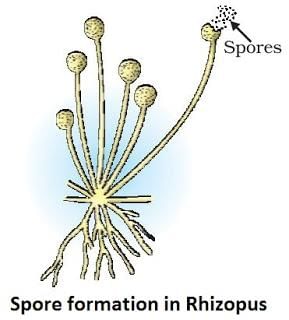
Sexual Reproduction
→ When reproduction takes place as a result of the fusion of male and female gametes is called sexual reproduction.
→ Fusion of gametes is called fertilization which results in variation.
Sexual Reproduction in Plants
→ Flowers are the reproductive organs of plants.
→ A typical flower consists of four main whorls namely sepals, petals, stamen and pistil.
Types of Flowers
• Bisexual flower: Both male and female reproductive parts are present.
Example: Hibiscus, mustard.
• Unisexual flower: Either male or female reproductive part is present.
Example: Papaya, watermelon.
Structure of Flower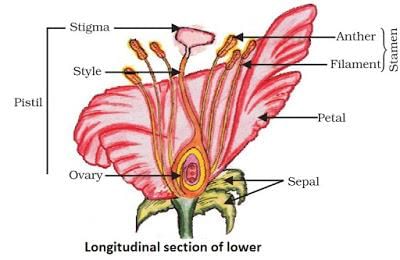
Process of Seed Formation
→ Pollen grains, produced in the anther, are transferred to the stigma of same flower (self pollination) or stigma of another flower (cross pollination) through agents like air, water or animals.
→ Pollen grains germinate and form pollen tubes which pass through style to reach upto the ovules present in ovary.
→ The fusion of male and female gametes is called fertilization. Zygote is produced inside the ovary.
→ Zygote divides to form embryo. Ovule develops thick coat and changes into seed gradually.
→ Ovary changes into fruit and other parts of flower fall off.
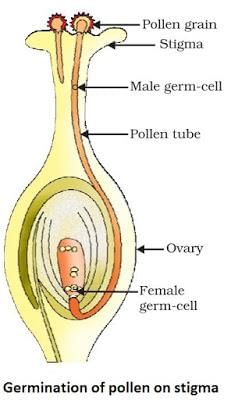
--->The seed germinates to form a plant under suitable conditions such as air, moisture etc.
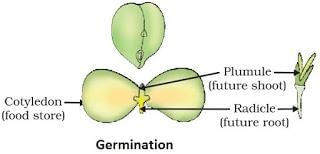
Reproduction in Human Beings
→ Humans use sexual mode of reproduction.
→ Sexual maturation: The period of life when production of germ cells i.e. ova (female) and sperm (male) start in the body. This period of sexual maturation is called puberty.
Changes at Puberty
• Common in male and female
→ Thick hair growth in armpits and genital area.
→ Skin becomes oily, may result in pimples.
• In girls
→ Breast size begin to increase.
→ Girls begin to menstruate.
• In boys
→ Thick hair growth on face.
→ Voice begin to crack.
These changes signals that sexual maturity is taking place.
Male Reproductive System
(i) Testes
→ A pair of testes are located inside scrotum which is present outside the abdominal cavity.
→ Scrotum has a relatively lower temperature needed for the production of sperms.
→ Male germ cell i.e. sperms are formed here.
→ Testes release male sex hormone (testosterone).
Function of testes:
→ Regulate production of sperms.
→ Bring changes at puberty.
(ii) Vas deferens
→ It passes sperms from testes upto urethera.
(iii) Urethera
→ It is a common passage for both sperms and urine. Its outer covering is called penis.
(iv) Associated glands
→ Seminal vesicles and prostate gland add their secretion to the sperms. This fluid provide nourishment to sperms and make their transport easy.
→ Sperm along with secretion of glands form semen.
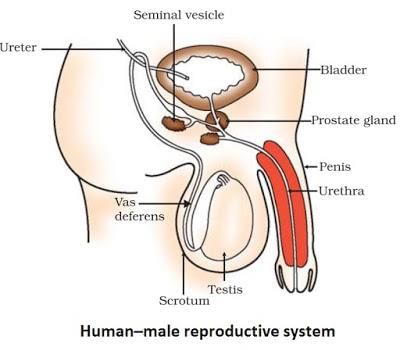
Female Reproductive System
(i) Ovary
→ A pair of ovary is located in both sides of abdomen.
→ Female germ cells i.e. eggs are produced here.
→ At the time of birth of a girl, thousands of immature eggs are present in the ovary.
→ At the onset of puberty, some of these eggs start maturing.
→ One egg is produced every month by one of the ovaries.
(ii) Oviduct or Fallopian tube
→ Receives the egg produced by the ovary and transfer it to the uterus.
→ Fertilisation i.e. fusion of gametes takes place here.
(iii) Uterus
→ It is a bag-like structure where development of the baby takes place.
→ Uterus opens into vagina through cervix.
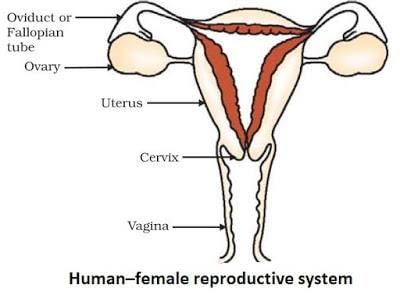
Fertilisation of egg
• When egg is fertilised
→ The fertilized egg called zygote is planted in uterus and develops into an embryo.
→ The embryo gets nutrition from the mother’s blood with the help of a special tissue called placenta. It provides a large surface area for the exchange of glucose, oxygen and waste material.
→ The time period from fertilization upto the birth of the baby is called gestation period. It is about 9 months.
• When egg is not fertilised
→ The uterus prepares itself every month to receive fertilized egg.
→ The lining of the uterus becomes thick and spongy, required to support the embryo.
→ When fertilisation had not taken place, this lining is not needed any longer.
→ This lining breaks and comes out through vagina as blood and mucus.
→ This cycle takes around 28 days every month and called menstruation.
Reproductive Health
→ Reproductive health means a total well-being in all aspects of reproduction i.e. physical, emotional, social and behavioural.
• Sexually Transmitted Diseases (STDs)
→ Many diseases can be sexually transmitted such as:
(i) Bacterial : Gonorrhoea and syphilis
(ii) Viral : Warts and HIV-AIDS
→ Use of condom prevents these infections to some extent.
→ Contraception: It is the avoidance of pregnancy, can be achieved by preventing the fertilisation of ova.
• Methods of contraception
(i) Physical barrier
→ To prevent union of egg and sperm.
→ Use of condoms, cervical caps and diaphragm.
(ii) Chemical methods
→ Use of oral pills
→ These change hormonal balance of body so that eggs are not released.
→ May have side effects.
(iii) Intrauterine contraceptive device (IUCD)
→ Copper-T or loop is placed in uterus to prevent pregnancy.
(iv) Surgical methods
→ In males the vas deferens is blocked to prevent sperm transfer called vasectomy.
→ In females, the fallopian tube is blocked to prevent egg transfer called tubectomy.
Female Foeticide
→ The practice of killing a female child inside the womb is called female foeticide.
→For a healthy society, a balanced sex ratio is needed that can be achieved by educating people to avoid malpractices like female foeticide and prenatal sex determination.
→ Prenatal sex determination is a legal offence in our country so as to maintain a balanced sex ratio.
Thanks for visiting !
Follow me for getting all the notification of my uploads !
• Multiple fission: Many cells are formed. Example: Plasmodium.

























